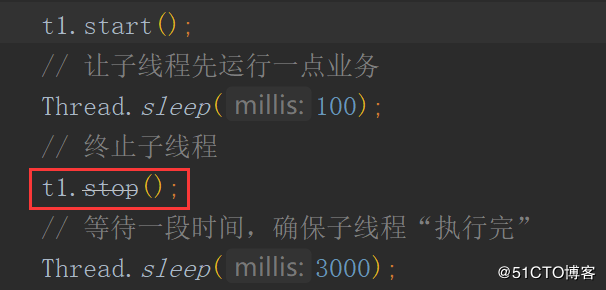震惊!这样终止线程,竟然会导致服务宕机?

这是我的第 46 篇原创文章。
在开始之前,我们先来看以下代码会有什么问题?
public class ThreadStopExample {
public static void main(String[] args) throws InterruptedException {
Thread t1 = new Thread(() -> {
try {
System.out.println("子线程开始执行");
// 模拟业务处理
Thread.sleep(1000);
} catch (Exception e) { }
// 伪代码:重要的业务方法
System.out.println("子线程的重要业务方法");
});
t1.start();
// 让子线程先运行一点业务
Thread.sleep(100);
// 终止子线程
t1.stop();
// 等待一段时间,确保子线程“执行完”
Thread.sleep(3000);
System.out.println("主线程执行完成");
}
}或许你已经发现了,上面这段代码使用了 Thread.stop() 来终止线程,在 Java 程序中是不允许这样终止线程的。什么?你问为什么不能这样?
首先来说 IDE 都会鄙视你了,它会阻止你使用 Thread.stop() !
什么?你不信。那么来看这张图:
好吧,那为什么不能这样用呢?总得给我一个敷衍的理由吧?
问题一:破坏了程序的完整性
其实是这样的,以文章刚开头的那段代码来说,它的执行结果是:
子线程开始执行
主线程执行完成
我们发现了一个惊天的大问题,最重要的那段伪代码竟然没执行,如下图所示:
可以看出使用 stop() 终止线程之后,线程剩余的部分代码会放弃执行,这样会造成严重的且不易被发现的惊天大 Bug,假如没有执行的那段代码是释放系统资源的代码,或者是此程序的主要逻辑处理代码。这就破坏了程序基本逻辑的完整性,导致意想不到的问题发生,而且它还很隐秘,不易被发现和修复。
有人说,这还不简单,我加个 finally 不就完了吗?
这???杠精哪都有,今年特别多。
行,既然这个说服不了你,咱接着往下看。
问题二:破坏了原子逻辑
我们知道在 Java 中 synchronized 属于独占式可重入悲观锁,如果我们使用它修饰代码,妥妥的多线程没问题,但如果碰到 stop() 方法就不一定了,直接来看代码吧。
public class ThreadStopExample {
public static void main(String[] args) throws InterruptedException {
MyThread myThread = new MyThread();
Thread t2 = new Thread(myThread);
// 开启线程
t2.start();
for (int i = 0; i < 10; i++) {
Thread t = new Thread(myThread);
t.start();
}
// 结束线程
t2.stop();
}
/**
* 自定义原子测试线程
*/
static class MyThread implements Runnable {
// 计数器
int num = 0;
@Override
public void run() {
// 同步代码块,保证原子操作
synchronized (MyThread.class) {
// 自增
num++;
try {
// 线程休眠 0.1 秒
Thread.sleep(100);
} catch (InterruptedException e) {
e.printStackTrace();
}
// 自减
num--;
System.out.println(Thread.currentThread().getName() + " | num=" + num);
}
}
}
}以上程序的执行结果为:
Thread-5 | num=1
Thread-4 | num=1
Thread-2 | num=1
Thread-1 | num=1
Thread-8 | num=1
Thread-6 | num=1
Thread-9 | num=1
Thread-3 | num=1
Thread-7 | num=1
Thread-10 | num=1从结果可以看出,以上代码经过 synchronized 修饰的 ++ 和 — 操作,到最后打印的结果 num 竟然不是 0,而是 1。
这是因为 stop() 方法会释放此线程中的所有锁,导致程序执行紊乱,破坏了程序的原子操作逻辑。
以上的这些问题,导致了 JDK 废弃了 stop() 的方法,它的废弃源码如下:
/**
* Forces the thread to stop executing.
* <p>
* If there is a security manager installed, its <code>checkAccess</code>
* method is called with <code>this</code>
* as its argument. This may result in a
* <code>SecurityException</code> being raised (in the current thread).
* <p>
* If this thread is different from the current thread (that is, the current
* thread is trying to stop a thread other than itself), the
* security manager‘s <code>checkPermission</code> method (with a
* <code>RuntimePermission("stopThread")</code> argument) is called in
* addition.
* Again, this may result in throwing a
* <code>SecurityException</code> (in the current thread).
* <p>
* The thread represented by this thread is forced to stop whatever
* it is doing abnormally and to throw a newly created
* <code>ThreadDeath</code> object as an exception.
* <p>
* It is permitted to stop a thread that has not yet been started.
* If the thread is eventually started, it immediately terminates.
* <p>
* An application should not normally try to catch
* <code>ThreadDeath</code> unless it must do some extraordinary
* cleanup operation (note that the throwing of
* <code>ThreadDeath</code> causes <code>finally</code> clauses of
* <code>try</code> statements to be executed before the thread
* officially dies). If a <code>catch</code> clause catches a
* <code>ThreadDeath</code> object, it is important to rethrow the
* object so that the thread actually dies.
* <p>
* The top-level error handler that reacts to otherwise uncaught
* exceptions does not print out a message or otherwise notify the
* application if the uncaught exception is an instance of
* <code>ThreadDeath</code>.
*
* @exception SecurityException if the current thread cannot
* modify this thread.
* @see #interrupt()
* @see #checkAccess()
* @see #run()
* @see #start()
* @see ThreadDeath
* @see ThreadGroup#uncaughtException(Thread,Throwable)
* @see SecurityManager#checkAccess(Thread)
* @see SecurityManager#checkPermission
* @deprecated This method is inherently unsafe. Stopping a thread with
* Thread.stop causes it to unlock all of the monitors that it
* has locked (as a natural consequence of the unchecked
* <code>ThreadDeath</code> exception propagating up the stack). If
* any of the objects previously protected by these monitors were in
* an inconsistent state, the damaged objects become visible to
* other threads, potentially resulting in arbitrary behavior. Many
* uses of <code>stop</code> should be replaced by code that simply
* modifies some variable to indicate that the target thread should
* stop running. The target thread should check this variable
* regularly, and return from its run method in an orderly fashion
* if the variable indicates that it is to stop running. If the
* target thread waits for long periods (on a condition variable,
* for example), the <code>interrupt</code> method should be used to
* interrupt the wait.
* For more information, see
* <a href="{@docRoot}/../technotes/guides/concurrency/threadPrimitiveDeprecation.html">Why
* are Thread.stop, Thread.suspend and Thread.resume Deprecated?</a>.
*/
@Deprecated
public final void stop() {
SecurityManager security = System.getSecurityManager();
if (security != null) {
checkAccess();
if (this != Thread.currentThread()) {
security.checkPermission(SecurityConstants.STOP_THREAD_PERMISSION);
}
}
// A zero status value corresponds to "NEW", it can‘t change to
// not-NEW because we hold the lock.
if (threadStatus != 0) {
resume(); // Wake up thread if it was suspended; no-op otherwise
}
// The VM can handle all thread states
stop0(new ThreadDeath());
}可以看出 stop() 方法被 @Deprecated 注释修饰了,而被此注解修饰的代码表示为过时方法,不建议被使用。从 stop() 的备注信息可以看出,官方也不建议使用 stop() ,说它是一个非安全的方法。
正确终止线程
那如何终止线程呢?这里提供 2 个正确的方法:
设置退出标识退出线程;
使用 interrupt() 方法终止线程。
1.自定义退出标识
我们可以自定义一个布尔变量来标识是否需要退出线程,实现代码如下:
// 自定义退出标识退出线程
static class FlagThread extends Thread {
public volatile boolean exit = false;
public void run() {
while (!exit) {
// 执行正常的业务逻辑
}
}
}可以看出我们使用了关键字 volatile 对线程进行了修饰,这样就可以保证多线程的执行安全了,在我们需要让线程退出时,只需要把变量 exit 赋值为 true 就可以了。
2.interrupt 终止线程
当我们使用 interrupt() 方法时,以上两个示例的执行结果就正常了,执行代码如下:
public class ThreadStopExample {
public static void main(String[] args) throws InterruptedException {
// 问题一:破坏了程序的完整性
Thread t1 = new Thread(() -> {
try {
System.out.println("子线程开始执行");
// 模拟业务处理
Thread.sleep(1000);
} catch (Exception e) { }
// 伪代码:重要业务方法
System.out.println("子线程的重要业务方法");
});
t1.start();
// 让子线程先运行一点业务
Thread.sleep(100);
// 终止子线程
t1.interrupt();
// 等待一段时间,确保子线程“执行完”
Thread.sleep(3000);
System.out.println("主线程执行完成");
// 问题二:破坏了原子逻辑
MyThread myThread = new MyThread();
Thread t2 = new Thread(myThread);
// 开启线程
t2.start();
for (int i = 0; i < 10; i++) {
Thread t = new Thread(myThread);
t.start();
}
// 结束线程
t2.interrupt();
}
/**
* 自定义原子测试线程
*/
static class MyThread implements Runnable {
// 计数器
int num = 0;
@Override
public void run() {
// 同步代码块,保证原子操作
synchronized (MyThread.class) {
// 自增
num++;
try {
// 线程休眠 0.1 秒
Thread.sleep(100);
} catch (InterruptedException e) {
System.out.println(e.getMessage());
}
// 自减
num--;
System.out.println(Thread.currentThread().getName() + " | num=" + num);
}
}
}
}以上程序的执行结果为:
子线程开始执行
子线程的重要业务方法
主线程执行完成
sleep interrupted
Thread-1 | num=0
Thread-9 | num=0
Thread-10 | num=0
Thread-7 | num=0
Thread-6 | num=0
Thread-5 | num=0
Thread-4 | num=0
Thread-2 | num=0
Thread-3 | num=0
Thread-11 | num=0
Thread-8 | num=0可以看出以上的执行都符合我们的预期,这才是正确的终止线程的方式。
总结
本文我们讲了线程的三种终止方式,自定义退出标识的方式、使用 stop() 的方式或 interrupt() 的方式。其中 stop() 的方式会导致程序的完整性和原子性被破坏的问题,并且此方法被 JDK 标识为过期方法,不建议使用,而 interrupt() 方法无疑是最适合我们的终止线程的方式。
99%的程序员都在用Lombok,原理竟然这么简单?我也手撸了一个!|建议收藏!!!
别用 Date 了,来试试这几个类吧!
惊呆了,竟然可以用这种方式秒建Redis集群?
关注下方二维码,订阅更多精彩内容
震惊!这样终止线程,竟然会导致服务宕机?
原文:https://blog.51cto.com/13904087/2515076
![震惊!这样终止线程,竟然会导致服务宕机?[编程语言教程]](https://www.zixueka.com/wp-content/uploads/2024/01/1706715054-319b2c2c77fdf70.jpg)